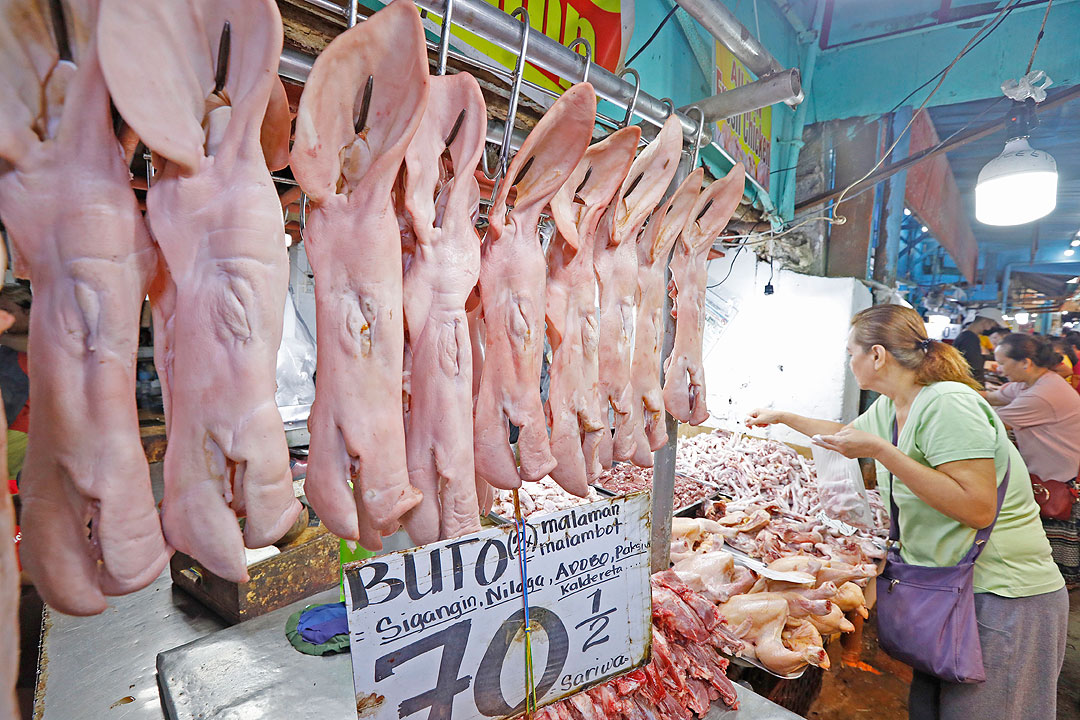
THE PHILIPPINES is expected to produce a lower volume of pork due to the continuous spread of African swine fever (ASF) in top-producing regions, the United States Department of Agriculture (USDA) said.
The USDA estimated the country’s pork production to reach 925,000 metric tons (MT), down by 5.13% from its previous forecast of 975,000 MT.
The agency lowered its projection in response to ASF’s continuous spread into other provinces within the Central and Western Visayas regions, including Negros Occidental, Negros Oriental, and Aklan.
“In 2022, the Central and Western Visayas regions had become the first and third-largest producers following the decimation of swine inventories elsewhere in the country,” the USDA said.
The production from Central Visayas, which accounted for 13.2% of the overall pork output, rose by 7% to 2.78 million MT last year. Pork output from Western Visayas increased by 12.4% to 2.61 million MT or 12.4% of the total production.
The agency noted, however, that the projection has not covered the impact on output brought by earlier outbreaks in the provinces of Iloilo and Cebu within the said regions.
The USDA said that despite prospects of an ASF vaccine following successful local trials, “such a vaccine would be unlikely to materially impact 2023 production.”
Earlier this month, the Bureau of Animal Industry (BAI) said that it had completed clinical trials. The agency has sent a letter of endorsement to the Food and Drug Administration for the issuance of a certificate of product registration.
As of June 1, up to 15 provinces have active ASF cases, according to the BAI. It said the cases had been confined to the Visayas region while few detections had been reported in Luzon and Mindanao.
Jayson H. Cainglet, executive director of Samahang Industriya ng Agrikultura, reiterated the call for the creation of first border facilities to contain the ASF outbreak.
“Without first border inspection facilities and indemnification from the government, the spread of ASF will continue. Unfortunately, it is the backyard farms that are being infected dahil sila ang hindi pa makasabay sa (because they are the ones that still can’t catch up with) enhanced biosecurity sa (in) farms,” he said in a Viber message.
The USDA also lowered its projection of pork imports this year to 500,000 MT from the initial forecast of 525,000 MT.
Citing the BAI data, pork imports dropped by 17% to 114,820 MT during the first quarter.
Meanwhile, the Philippines is said to have held higher frozen inventories “to support its supply chain and begun rebuilding stocks on time with historical precedent.”
“Importers will face a similar dilemma at the end of 2023 as they had in 2022, needing to decide how much extra to hold given the continued uncertainty of another extension of lower import duties,” the USDA said.
The agency said that retail prices of local pork “continue to hold steady” while imported pork and local farmgate prices are seen declining.
As of Friday, price monitoring of the Department of Agriculture (DA) indicated that markets in Metro Manila sold pork belly or liempo at between P310 and P390 per kilo while pork shoulder or kasim at P280 to P340 per kilo.
CHICKEN OUTPUT FORECAST
Chicken production and imports are seen to be flat at 1.47 million MT and 520,000 MT, respectively, according to the USDA.
“Philippine poultry industry contacts have voiced increased interest in a potential bird flu vaccine to help combat the now long-standing threat HPAI (highly pathogenic avian influenza) has posed and hope there will be a decision on the authorization and emergency use of avian influenza vaccines by September 2023,” the USDA said.
In terms of inventory, frozen chicken meat, excluding mechanically deboned meat, in accredited cold storage facilities remains “near historically high levels and reflective of growing import requirements,” according to the agency.
The Philippine Statistics Authority reported that the first-quarter production of chicken has increased by 3.3% year on year to 470,210 MT.
Meanwhile, chicken imports rose by 32% to 102,745 MT during the first quarter as per data from the BAI.
“Chicken retail prices remain elevated with a growing spread compared to farmgate in 2023,” it said.
Whole chicken was sold between P150 and P200 per kilo in Metro Manila markets, according to the DA. — Sheldeen Joy Talavera
USDA expects country’s pork output to drop 5%
Source: Bantay Radio
0 Comments